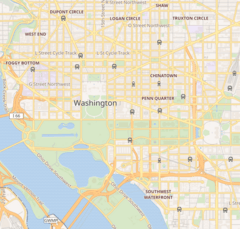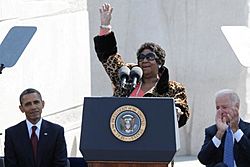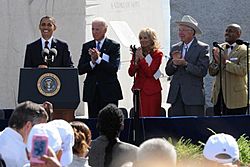Martin Luther King Jr. Memorial facts for kids
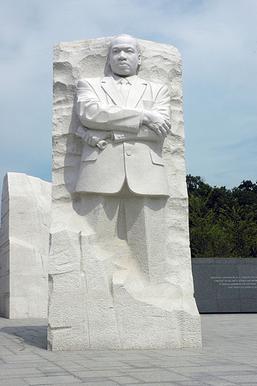
The Stone of Hope at the Martin Luther King, Jr. Memorial
|
|
| Coordinates | 38°53′10″N 77°2′39″W / 38.88611°N 77.04417°W |
|---|---|
| Location | 1964 Independence Ave. SW, Washington, D.C. |
| Designer | Lei Yixin |
| Material | White granite |
| Height | 30 ft (9.1 m) |
| Beginning date | 2009 |
| Completion date | 2011 |
| Opening date | August 22, 2011 |
| Dedicated to | Martin Luther King Jr. |
| Website | Martin Luther King, Jr. Memorial |
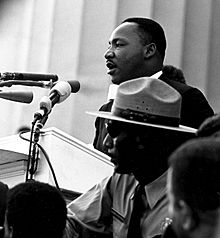
The Martin Luther King, Jr. Memorial is a national memorial located in West Potomac Park next to the National Mall in Washington, D.C., United States. It covers four acres (1.6 ha) and includes the Stone of Hope, a granite statue of Civil Rights Movement leader Martin Luther King Jr. carved by sculptor Lei Yixin. The inspiration for the memorial design is a line from King's "I Have a Dream" speech: "Out of the mountain of despair, a stone of hope." The memorial opened to the public on August 22, 2011, after more than two decades of planning, fund-raising, and construction.
Although this is not the first memorial to an African American in Washington, D.C., King is the first African American honored with a memorial on or near the National Mall and only the fourth non-President to be memorialized in such a way. The King Memorial is administered by the National Park Service (NPS).
Contents
History
The idea for a memorial honoring Dr. King began to gain momentum in the late 1960s, shortly after his assassination on April 4, 1968. However, it took many years of planning, fundraising, and design work before the project could become a reality. The official effort to create a memorial began in earnest in 1986, when Congress authorized the creation of a memorial to commemorate Dr. King's life and achievements.
The design process was a significant undertaking. Many different proposals were submitted, and the final design, chosen in 2004, was created by the renowned sculptor, Lei Yixin. The design was selected from over 90 proposals. The construction of the memorial began in 2008 and was completed in 2011, costing approximately $120 million. This cost included not only the construction of the monument itself but also the landscaping, infrastructure improvements, and other related expenses. The memorial was officially dedicated on August 22, 2011, marking a significant moment in American history.
Location
The street address for the memorial is 1964 Independence Avenue SW in Washington, D.C. The address "1964" was chosen as a direct reference to the 1964 Civil Rights Act, a milestone in the Civil Rights Movement in which King played an important role. The memorial is located on a 4-acre (1.6 ha) site in West Potomac Park that borders the Tidal Basin, southwest of the National Mall. The memorial is near the Franklin Delano Roosevelt Memorial and is intended to create a visual "line of leadership" from the Lincoln Memorial, on whose steps King gave his "I Have a Dream" speech at the March on Washington, to the Jefferson Memorial.
Design and symbolism
The memorial's design is both powerful and deeply symbolic. The centerpiece is a massive 30-foot-tall statue of Dr. King, carved from a single block of Georgia granite. This choice of material is significant, as Georgia is a state with a rich history, and the granite represents the strength and endurance of Dr. King's character. The statue depicts Dr. King in a contemplative pose, his gaze directed towards the horizon, symbolizing his vision for a better future.
Surrounding the central statue are four large inscriptions, each quoting one of Dr. King's famous speeches or writings. These quotes are carefully chosen to represent the core principles of his philosophy: justice, equality, peace, and hope.
The fourteen quotes on the Inscription Wall are:
- "We shall overcome because the arc of the moral universe is long, but it bends towards justice." (March 31, 1968, National Cathedral, Washington, D.C.)
- "Darkness cannot drive out darkness, only light can do that. Hate cannot drive out hate, only love can do that." (1963, Strength to Love)
- "I believe that unarmed truth and unconditional love will have the final word in reality. This is why right, temporarily defeated, is stronger than evil triumphant." (December 10, 1964, Oslo, Norway)
- "Make a career of humanity. Commit yourself to the noble struggle for equal rights. You will make a greater person of yourself, a greater nation of your country, and a finer world to live in." (April 18, 1959, Washington, D.C.)
- "I oppose the war in Vietnam because I love America. I speak out against it not in anger but with anxiety and sorrow in my heart, and above all with a passionate desire to see our beloved country stand as a moral example of the world." (February 25, 1967, Los Angeles, California)
- "If we are to have peace on earth, our loyalties must become ecumenical rather than sectional. Our loyalties must transcend our race, our tribe, our class, and our nation; and this means we must develop a world perspective." (December 24, 1967, Atlanta, Georgia)
- "Injustice anywhere is a threat to justice everywhere. We are caught in an inescapable network of mutuality, tied in a single garment of destiny. Whatever affects one directly, affects all indirectly." (April 16, 1963, Birmingham, Alabama)
- "I have the audacity to believe that peoples everywhere can have three meals a day for their bodies, education and culture for their minds, and dignity, equality and freedom for their spirits." (December 10, 1964, Oslo, Norway)
- "It is not enough to say 'We must not wage war.' It is necessary to love peace and sacrifice for it. We must concentrate not merely on the negative expulsion of war, but on the positive affirmation of peace." (December 24, 1967, Atlanta, Georgia)
- "The ultimate measure of a man is not where he stands in moments of comfort and convenience, but where he stands at times of challenge and controversy." (February 25, 1967, Los Angeles, California)
- "Every nation must now develop an overriding loyalty to mankind as a whole in order to preserve the best in their individual societies." (April 4, 1967, Riverside Church, Manhattan, New York)
- "We are determined here in Montgomery to work and fight until justice runs down like water, and righteousness like a mighty stream." (December 5, 1955, Montgomery, Alabama)
- "We must come to see that the end we seek is a society at peace with itself, a society that can live with its conscience." (April 16, 1963, Birmingham, Alabama)
- "True peace is not merely the absence of tension: it is the presence of justice." (April 16, 1963, Birmingham, Alabama)
The memorial also features a "Stone of Hope," a large, polished granite stone that sits at the base of the statue. This stone serves as a symbol of the hope and optimism that Dr. King embodied throughout his life.
The memorial's design also incorporates elements of nature, including trees, water features, and carefully landscaped gardens. These elements create a serene and peaceful atmosphere, allowing visitors to reflect on Dr. King's life and work in a contemplative setting. The landscaping is designed to complement the architecture of the memorial, creating a harmonious and visually appealing space. The careful integration of nature and architecture enhances the overall impact of the memorial.
Impact and legacy
The Martin Luther King, Jr. Memorial has become a significant landmark in Washington, D.C., attracting millions of visitors each year. It serves as a powerful reminder of Dr. King's contributions to the fight for civil rights and social justice. The memorial is not just a place to visit; it's a place to learn, reflect, and be inspired.
The memorial's impact extends beyond its physical presence. It has become a symbol of hope and inspiration for people around the world who are fighting for equality and justice. The memorial's design and symbolism have resonated with people from diverse backgrounds, making it a truly universal symbol of peace and reconciliation. The memorial's enduring legacy is a testament to the power of Dr. King's message and the importance of continuing the fight for equality and justice.
The memorial's educational value is also significant. Many schools and organizations use the memorial as a site for educational tours and programs. These programs provide students and visitors with the opportunity to learn about Dr. King's life, work, and legacy in a meaningful and engaging way. The memorial's educational resources, including guided tours and interactive exhibits, enhance the learning experience.
The memorial's impact on the community is also noteworthy. It has become a gathering place for community events, celebrations, and commemorations. The memorial's open space and peaceful atmosphere provide a welcoming environment for community gatherings. The memorial's accessibility and inclusivity make it a valuable asset to the community.
Numbers and facts
- Height of the statue: 30 feet
- Weight of the statue: approximately 30,000 pounds
- Cost of construction: approximately $120 million
- Date of dedication: August 22, 2011
- Annual visitors: millions
- Location: National Mall, Washington, D.C.
- Material of the statue: Georgia granite
- Designer: Lei Yixin
- Authorized by Congress: 1986
- Groundbreaking: 2008
- Completion: 2011
Artists
Artists involved in the design and construction of the memorial include:
- Lei Yixin, sculptor
- Wang Xiangrong, sculptor from Dingli Stone Carving
- Nicholas Benson, Inscription designer and stone carver
- Bob Fitch, SCLC Staff Photographer, whose photo image of King in his office in front of a photograph of Mohandas Gandhi was the basis for the monument
- Devraux and Purnell/ROMA Design Group Joint Ventures
- McKissack and McKissack/Turner Construction Company/Tompkins Builders, Inc./Gilford Corporation Joint Ventures
Images for kids
See also
 In Spanish: Monumento a Martin Luther King, Jr. para niños
In Spanish: Monumento a Martin Luther King, Jr. para niños
- Martin Luther King Jr. Memorial Library
- Civil rights movement in popular culture
- List of memorials to Martin Luther King Jr.
- List of national memorials of the United States


